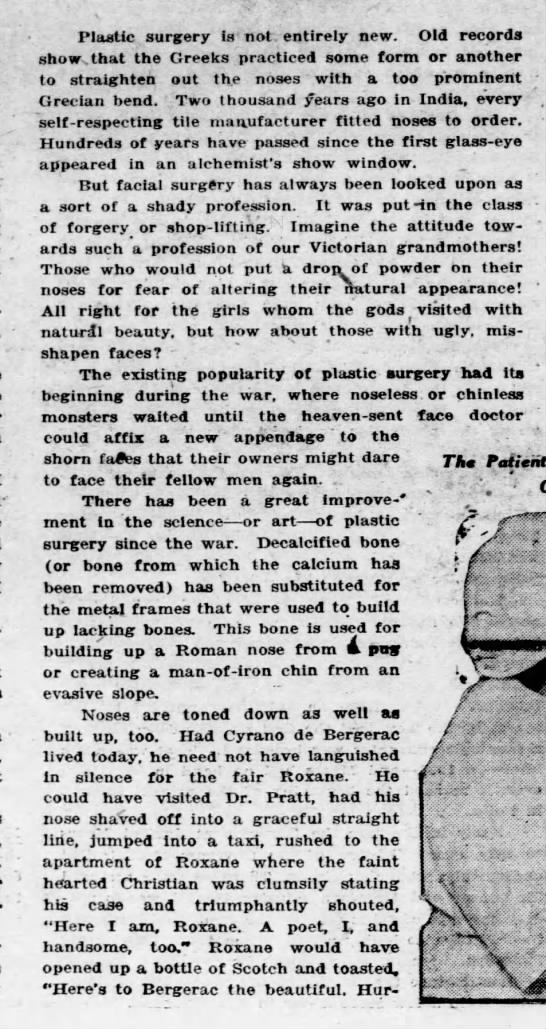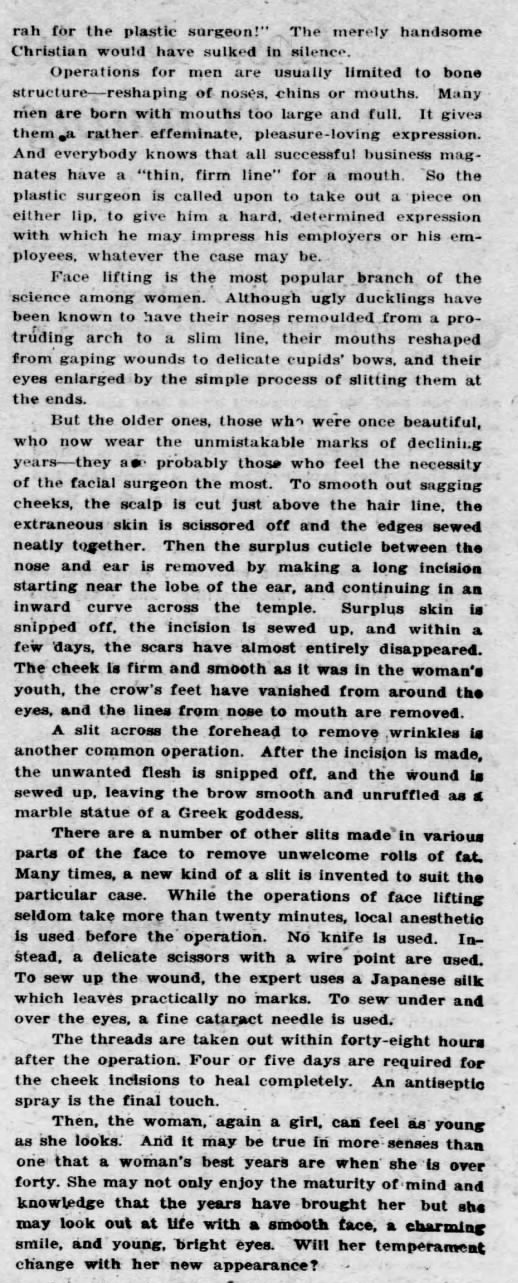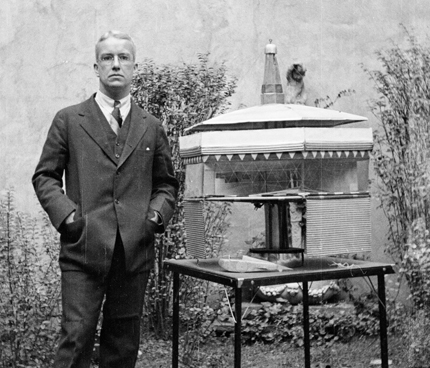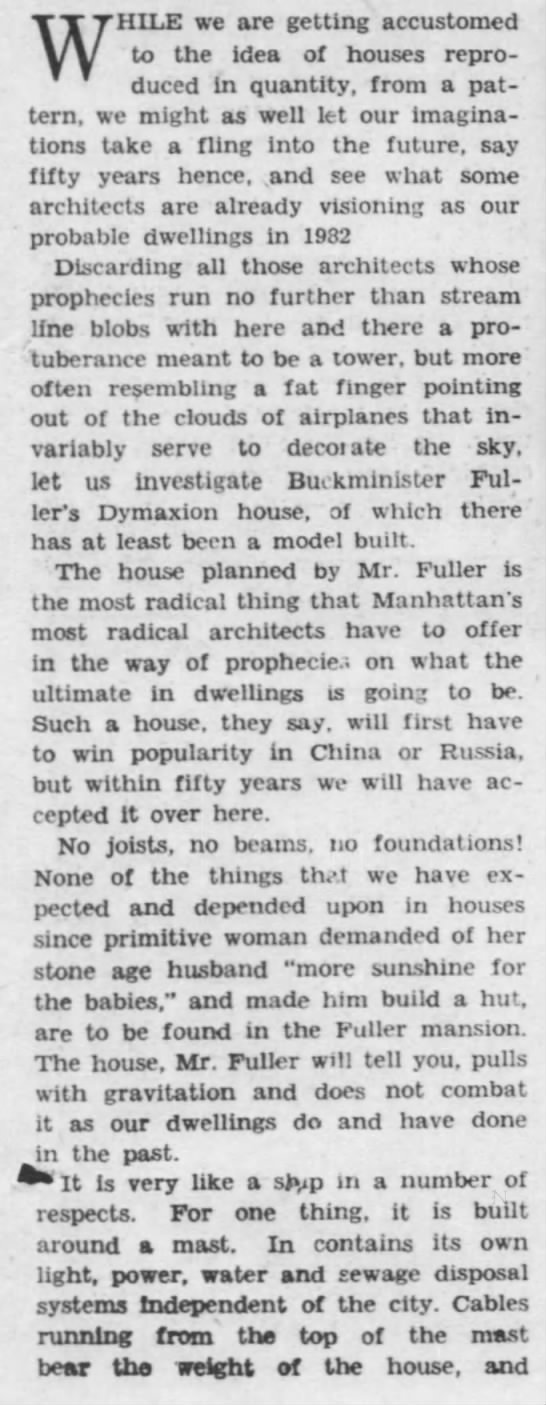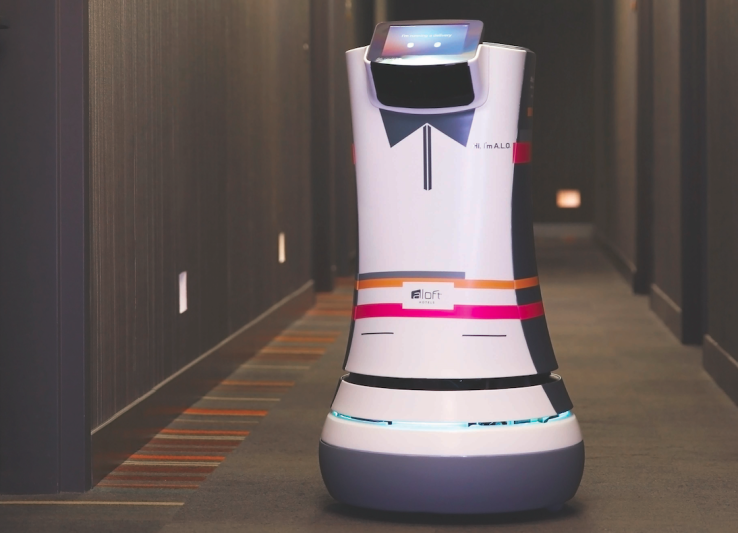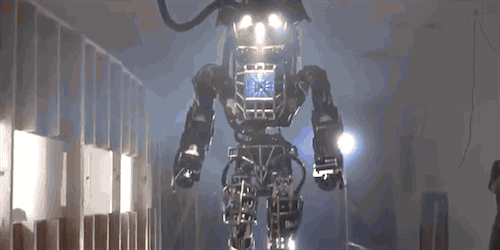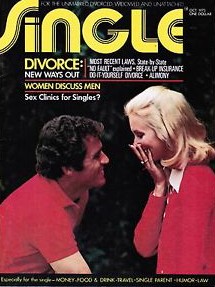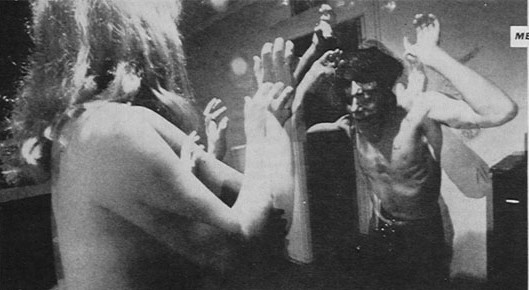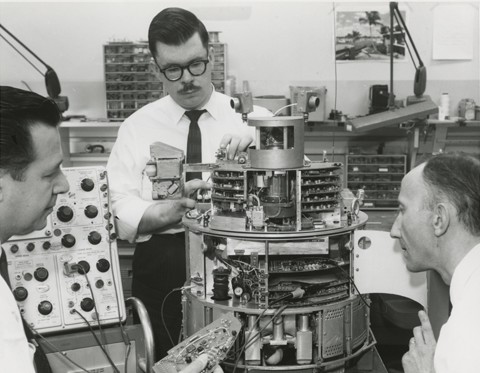So much going on in this 1924 Brooklyn Daily Eagle feature about the plastic surgery practice of one Dr. W. Augustus Pratt. The early part of the piece mentions the surgeries endured by a 48-year-old woman who wanted to put a permissible face on her May-December relationship with a 16-year-old drug-store clerk. The indelicate article refers to injured WWI veterans as “noseless or chinless monsters.” It goes on to focus on women’s efforts to cosmetically remake themselves for beauty and men for professional reasons. Dr. Pratt, by the way, married one of his patients after “perfecting” her, though, as you can see from the photo at the bottom, he could have used a few nips and/or tucks himself.
You are currently browsing the archive for the Urban Studies category.
Tags: Dr. W.A. Pratt, Marion T. Byrnes
From the June 5, 1934 Brooklyn Daily Eagle:
Simla, India — Religious pilgrims reported today that the aged Shamanist abbot of a temple near Bareilly has been buried alive at his own request.
The abbot, who was reported to be 157 years old, believed his life’s work was over, and that to live on would be an affront to the deities. Pilgrims reported he lay down in a grave and that faithful followers, after performing ancient ceremonies, covered him with earth.•
Figuring out the future of paid journalism isn’t just about making the economics work but by doing so while actually turning out original and intelligent reporting that has integrity. That’s something often lost on media analysts eager to bury the legacy of twentieth-century journalism, a mixed bag, sure, but an era that saw the best of reportage reach never-before-seen heights. We live in a fuller and deeper time because everyone is potentially a citizen journalist (a good thing), but we shouldn’t reflexively accept Buzzfeed and the like as the way forward simply because of page views or ad sales. From James King’s Gawker post, “My Year Ripping Off the Web With the Daily Mail Online“:
The eager paradigm-proclaimer Michael Wolff used his USA Today media column last August to praise the Mail’s business model as having succeeded where other, better-funded and more prestigious publications have failed. Under the headline “Daily Mail Solves Internet Paradox,” Wolff lauded the publication’s “180 million unique visitors a month” and suggested that if other publications want to survive the “digital migration” they should adopt a model similar to that of the Mail’s.
What Wolff failed to acknowledge: the Mail’s editorial model depends on little more than dishonesty, theft of copyrighted material, and sensationalism so absurd that it crosses into fabrication.
Yes, most outlets regularly aggregate other publications’ work in the quest for readership and material, and yes, papers throughout history have strived for the grabbiest headlines facts will allow. But what DailyMail.com does goes beyond anything practiced by anything else calling itself a newspaper. In a little more than a year of working in the Mail’s New York newsroom, I saw basic journalism standards and ethics casually and routinely ignored. I saw other publications’ work lifted wholesale. I watched editors at the most highly trafficked English-language online newspaper in the world publish information they knew to be inaccurate.
“We do things a little differently than you might be used to,” U.S. editor Katherine Thomson told me, early in my time there.
She was right. …
The production process was simple. During a day shift—8 a.m. to about 6 p.m—four news editors stationed together near Clarke’s desk assigned stories to reporters from a continually updated list of other publications’ articles, to which I did not have access. Throughout the day, they would monitor the website’s traffic to determine what was getting clicked on and what to remove from the homepage.
When a writer was free to write a story, he or she simply would shout “I’m free” and an editor would assign a link to an article on the list. In many cases, it would be accompanied by a sensationalized headline—one that may or may not have been accurate—for the writer to use.
During a typical 10-hour shift, I would catch four to seven articles this way. Unlike at other publications for which I’ve worked, writers weren’t tasked with finding their own stories or calling sources. We were simply given stories written by other publications and essentially told to rewrite them. And unlike at other publications where aggregation writers are encouraged to find a unique angle or to add some information missing from an original report, the way to make a story your own at the Mail is to pass off someone else’s work as your own.•
Tags: James King, Katherine Thomson
A house that’s impervious to storm and earthquake sounds pretty good right about now, and that was what Buckminster Fuller promised in 1929 when he introduced the Dymaxion House, an architectural dream never realized beyond a few prototypes. In a 1932 Brooklyn Daily Eagle article from a series on the future of the home, Fuller’s automated abode was given a public hearing. The opening of the piece below.
____________________________
“We are living in a spheroidal universe”:
Tags: Buckminster Fuller, Lou Wylie
Google has withdrawn one of its recently purchased companies from the upcoming DARPA Robotics Challenge in Pomona, but the competition will continue apace, albeit with some accelerated marching orders (i.e., the cables have been cut). From Erico Guizzo at IEEE Spectrum:
In a call with reporters this afternoon, Gill Pratt, program manager for the DRC, said the tasks for the final challenge will be similar to the ones we saw at the trials. But this time the tasks will be “put together in a single mission” that teams have one hour to complete.
The robots will start in a vehicle, drive to a simulated disaster building, and then they’ll have to open doors, walk on rubble, and use tools. Finally they’ll have to climb a flight of stairs. But one more thing, Pratt said: there will be a surprise task waiting for the robots at the end.
Just when we thought the DRC couldn’t get any cooler—it just did. Naturally, Pratt declined to elaborate on what this mystery task might entail.
He also emphasized that now the robots will operate completely untethered. There won’t be cables to provide power and data—and to keep them from falling down. “They’ll have to get up on their own,” he said. “That’s raising the bar on how good the robots have to be.”•
___________________________
“Basically we have to cut the cord”:
Tags: Erico Guizzo, Gill Pratt
If I can help you in Africa to buy diamonds will u invest in me? – $250000 (The Real Deal)
From years of experience and operating in remote places, with the right sources, I can be a valuable partner.
Option 1. 50/50 partnership and I star making us a profit month 1.
Option 2. Strait investment loan and I make you 3% per Month
Do not miss on this oppt please.
I posted last fall about Aloft Hotels introducing robotic butlers, machines that will likely be roaming the halls of every hotel chain in the near future. Here’s video footage of one such “worker” providing room service.
Silicon Valley isn’t merely about money in the way of Wall Street, and it isn’t about power in the traditional sense. The true measure of success in the tech capital is impact, how many lives can be changed–allegedly for the better. It’s about the building of a huge and overarching mechanism that can’t be avoided. From “Tomorrowland: How Silicon Valley Shapes Our Future,“ Thomas Schulz’s Spiegel piece about the shift of influence from bankers to technologists and what that means:
The iPhone only made its appearance seven years ago, but most of us no longer remember what the world was like before. Driverless cars were considered to be a crazy fantasy not long ago, but today nobody is particularly amazed by them. All the world’s knowledge condensed into a digital map and easily accessible? Normal. The fact that algorithms in the US control some 70 percent of all trading on the stock market? Crazy, to be sure. But normal craziness.
Dozens of companies are trying to figure out how to use drones for commercial use, be it for deliveries, data collection or other purposes. Huge armies of engineers are chasing after the holy grail of artificial intelligence. And the advances keep coming. Machines that can learn, intelligent robots: We have begun overtaking science fiction.
The phenomenon is still misunderstood, first and foremost by policymakers. It appears they have not yet decided whether to dive in and create a usable policy framework for the future or to stand aside as others create a global revolution. After all, what we are witnessing is not just the triumph of a particular technology. And it is not just an economic phenomenon. It isn’t about “the Internet” or “the social networks,” nor is it about intelligence services and Edward Snowden or the question as to what Google is doing with our data. It isn’t about the huge numbers of newspapers that are going broke nor is it about jobs being replaced by software. It’s not about a messaging service being worth €19 billion ($21.1 billion) or the fact that 20-year-olds are launching entire new industries.
We are witnessing nothing less than a societal transformation that ultimately nobody will be able to avoid. It is the kind of sea change that can only be compared with 19th century industrialization, but it is happening much faster this time. Just as the change from hand work to mass production dramatically changed our society over 100 years ago, the digital revolution isn’t just altering specific sectors of the economy, it is changing the way we think and live.
This time, though, the transformation is different. This time, it is being driven by just a few hundred people.•
Tags: Thomas Schulz
From the June 13, 1867 Brooklyn Daily Eagle:
A school teacher in a Texas town was grossly insulted by a man, who told her at the same time that if she had any friends to avenge the insult that she could send them to him. The lady replied that she was able to protect herself, and, drawing a pistol, shot the man, killing him on the spot.•
Every day, hundreds of millions of people all over the world create an astounding amount of free content for Facebook and Twitter and the like. It would be by far the largest sweatshop in the world except that even sweatshop laborers are paid a nominal amount. Sure, we get a degree of utility from such services, but we’ve essentially turned ourselves into unpaid volunteers for multibillion-dollar corporations. There is, perhaps, something evolutionary about such participation, the ants cooperating to piece together a colony, but from an economic standpoint, it’s a stunning turn of events, and it all pivots on the new technologies.
“When Robots Steal Our Jobs,” a BBC radio program about machines and automation being introduced into reliably white-collar fields like law and medicine, sums up this phenomenon really well with this fact: “Last year, we collectively spent nearly 500 million hours each day updating Facebook. That’s 25 times the amount of labor it took to build the Panama Canal. And we did it all for free.”
Andrew McAfee, co-author of The Second Machine Age, and David Graeber are among the voices heard. The latter thinks capitalism won’t survive automation, but perhaps they’ll be something worse (e.g., techno-fascism).
One thing I feel sure about in the aforementioned intersection of AI and medicine is that robotics will be handling the majority of surgery at some point in the future.
The show plays a clip of Woody Allen doing stand-up in San Francisco in 1968, addressing a fear that began to take hold that decade: “My father was fired. He was technologically unemployed. My father worked for the same firm for 12 years. They replaced him with a tiny gadget this big that does everything that my father does but does it much better. The depressing thing is that my mother ran out and bought one.”
Tags: Andrew McAfee, David Graeber, Woody Allen
It’s possible I could read a better book during the rest of 2015 than Yuval Noah Harari’s Sapiens: A Brief History of Humankind, but I wouldn’t bet on it. Edge.org made my day as it often does with “Death Is Optional,” a dialogue between the Israeli historian and the psychologist Daniel Kahneman, another great thinker. Harari argues (as I have here many times) that computer consciousness is nowhere near a reality, but that Weak AI can displace and disrupt us regardless. The two consider the road ahead, a highly automated tomorrow in which medicine, even death, may not be an egalitarian affair (though it never was completely). An excerpt:
Daniel Kahneman:
Do you get to a broader view by becoming more differentiated, that is, by having more detailed views? Or is it just that you get people to consider a possibility that wouldn’t occur to them?
Yuval Noah Harari:
Mainly, the second way. The main thing, and my main task as a historian is to get people to consider the possibilities which usually are outside their field of vision, because our present field of vision has been shaped by history and has been narrowed down by history, and if you understand how history has narrowed down our field of vision, this is what enables you to start broadening it.
Let me give you an example that I’m thinking about a lot today, concerning the future of humankind in the field of medicine. At least to the best of my understanding, we’re in the middle of a revolution in medicine. After medicine in the 20th century focused on healing the sick, now it is more and more focused on upgrading the healthy, which is a completely different project. And it’s a fundamentally different project in social and political terms, because whereas healing the sick is an egalitarian project … you assume there is a norm of health, anybody that falls below the norm, you try to give them a push to come back to the norm, upgrading is by definition an elitist project. There is no norm that can be applicable to everybody.
And this opens the possibility of creating huge gaps between the rich and the poor, bigger than ever existed before in history. And many people say no, it will not happen, because we have the experience of the 20th century, that we had many medical advances, beginning with the rich or with the most advanced countries, and gradually they trickled down to everybody, and now everybody enjoys antibiotics or vaccinations or whatever, so this will happen again.
And as a historian, my main task is to say no, there were peculiar reasons why medicine in the 20th century was egalitarian, why the discoveries trickled down to everybody. These unique conditions may not repeat themselves in the 21st century, so you should broaden your thinking, and you should take into consideration the possibility that medicine in the 21st century will be elitist, and that you will see growing gaps because of that, biological gaps between rich and poor and between different countries. And you cannot just trust a process of trickling down to solve this problem.
There are fundamental reasons why we should take this very seriously, because generally speaking, when you look at the 20th century, it’s the era of the masses, mass politics, mass economics. Every human being has value, has political, economic, and military value, simply because he or she is a human being, and this goes back to the structures of the military and of the economy, where every human being is valuable as a soldier in the trenches and as a worker in the factory.
But in the 21st century, there is a good chance that most humans will lose, they are losing, their military and economic value. This is true for the military, it’s done, it’s over. The age of the masses is over. We are no longer in the First World War, where you take millions of soldiers, give each one a rifle and have them run forward. And the same thing perhaps is happening in the economy. Maybe the biggest question of 21st century economics is what will be the need in the economy for most people in the year 2050.
And once most people are no longer really necessary, for the military and for the economy, the idea that you will continue to have mass medicine is not so certain. Could be. It’s not a prophecy, but you should take very seriously the option that people will lose their military and economic value, and medicine will follow.•
Tags: Daniel Kahneman, Yuval Noah Harari
IQ continues to increase globally (if unevenly), and it’s not only in developing nations playing catch-up (China, for a huge example) but also in long-developed ones (the U.S., that other ginormous example). Why is that? Better tools and an improved understanding of tests? Perhaps, but the man who gave the Flynn effect its name believes abstract thinking is at the heart of the steady incline. Does that mean, as I’ve always suspected, that video games are good for us? From William Kremer at the BBC:
James Flynn believes test wiseness may have been a factor in IQ gains in the US in the first half of the 20th Century. However, since then the amount of IQ testing taking place has waned – and IQ increases have remained steady.
Flynn puts this continued progress down to profound shifts in society as well as education over the last century, which have led people to think in a more abstract, scientific way – the kind of intelligence measured by IQ tests.
He cites the work of Russian neuroscientist Alexander Luria, who studied indigenous people in the Soviet Union. “He found that they were very pragmatic and concrete in their thinking,” says Flynn, “and they weren’t capable of using logical abstractions or taking hypotheticals seriously.” Luria put the following problem to the head man of one tribe in Siberia: Where there’s always snow, the bears are white; there’s always snow at the North Pole – what colour are the bears there?
The head man replied that he had never seen bears that were any colour other than brown, but if a wise or truthful man came from the North Pole and told him that bears there were white, he might believe him. The scientific methods of hypothesising, classifying and making logical deductions were alien to him.
“Now virtually all formal schooling, when you get past the sixth grade into high school and college, means that you take hypotheses seriously,” says Flynn. “This is what science is all about. And you’re using logic on abstract categories.”
And this kind of thinking doesn’t only occur in school.•
Tags: Alexander Luria, James Flynn, William Kremer
Your city will likely be a smart one eventually, and you won’t have much of a say in the matter. It will all flow beneath the surface and you may consider it as infrequently as you do electricity. That will mean constant quantification which will lead to some good things and, quietly, some that are not. An excerpt from a heady talk at Salon (via Alternet) about the nature of smart cities, between journalist Allegra Kirkland and urban theorist Catherine Tumber:
Allegra Kirkland:
It seems like there’s a fundamental split between people who think there is something organic and inexplicable about the ways human beings come together in cities, and those who believe that all human behavior is quantifiable—that we can rely on data to understand how humans interact. Which side of the line do you fall on?
Catherine Tumber:
Digital technology and its use compresses experience. It tends to lead to niche cultures; it tends to lead to a sense of being untethered, as if that’s the golden pathway to real freedom. There are several traditions of political philosophy that hold that its important to be tethered so that you have a sense of the limits of yourself and of what it is that humans can do in the time that they have on this earth. This sense of endless freedom can lead to a very false sense of utopian promise that is simply unrealistic and unwanted. It’s yet another way that we’ve decided to take a pause from history and what history has long told us.
There are some things that you really don’t play with. People have acquired great wisdom over the ages—across the globe, this isn’t just a Eurocentric thing—about what it means to travel and to leave home and to come back. These are all the great stories and myths and fables. Technology kind of flattens all of that.
Allegra Kirkland:
This is sort of a related question, but what do you think are the primary things smart cities take away from the people who live there? What do we lose in these sorts of manufactured urban environments?
It makes me think of the complaints about the gentrification of places like New York City. Michael Bloomberg created new green spaces in Times Square and along the waterfront, made city services more efficient, rezoned districts, and now we have this sanitized, business-friendly, soulless city. The neighborhoods look the same; there’s no mixing of social classes, no weird dive bars. So you’d think smart cities, with their emphasis on homogeneity and efficiency, would be equally off-putting to people.
Catherine Tumber:
I think it’s a matter of the convenience of it and the novelty of it. But smart technology is relatively new and there are so many unexamined consequences, as I think there are with any major technological change like this.
I think that we’re only beginning as a culture to wince a little and take a second look at this. … There really hasn’t been any sort of consensus about what the right manners are in using these technologies. Across the world for time immemorial, every culture had some understanding of manners, and I don’t mean that in the prim Victorian sense. But just some ways in which you convey unspoken, coded assumptions about respect and caring and common courtesy and stuff like that. We haven’t had that conversation here. …The main point is that there are real unintended consequences of this.•
Tags: Allegra Kirkland, Catherine Tumber
The Mormon polygamists of Short Creek, Arizona, near the border of Utah, had long vexed local authorities with their alternative lifestyle, but things came to a head in 1953 when the largest mass arrest of such people–perhaps any people–in American history to that point occurred. The state believed they were bringing to a close a chapter it found disquieting, but it was only a temporary interruption. The town renamed itself Colorado City and Warren Jeffs, the polygamous sect leader, held dominion over much of the land more than 50 years later when convicted of sex charges against children. A report about the raid from the July 27, 1953 Brooklyn Daily Eagle:
The New York City I grew up with is no longer here, and that’s no surprise. It’s always been a place constantly tearing down and building up. But if climate change truly unfolds in a worst-case scenario–or a very bad one, at least–what does that mean for the city? Was Hurricane Sandy just prelude? Will Manhattan, an island crowded with skyscrapers, become Venice? Will it stand on stilts, trying to keep its balance? From Neel V. Patel’s Wired piece “How Climate Change Will Alter New York City’s Skyline,” about a time when weather may continually be an “event”:
Last week’s report estimates that average annual rainfall in New York City will increase between 5 and 13 percent by the 2080s. Sea levels could be as high as six feet by 2100, doubling the area of the city currently at risk for severe flooding. And that’s without taking into account results published this week in Nature that found coastal sea level north of New York City had jumped temporarily by more than five inches between 2009-2010—an extreme, unprecedented event scientists partially blame on climate change.
That means that New Yorkers will first have to radically reinterpret how they use their basements and ground floors. Building owners in flood zones will be responsible for raising habitable spaces up; the city’s Office of Recovery plans to keep ground floors least 2 feet above projected sea level. One way to do that: Abandon all pretense of actually living on the ground floor. Alex Wilson, president of the Resilient Design Institute, advocates for clearing out ground floors and basements in buildings that are at-risk for frequent flooding, and adapting them to let water move in and drain out with minimal damage. “It’s a big challenge if they need to renovate those spaces so they can be flooded,” says Wilson. “That means losing those apartments, moving equipment like boilers to higher floors, and most of all making sure residents have some place to go.”
Buildings will also have to adapt to rising temperatures. New York is going to get much hotter, with average temperatures increasing by as much as 8.8 degrees Fahrenheit by the the 2080s. And the number of heat waves per year will likely triple from two to six.•
Tags: Alex Wilson, Neel V. Patel
Hours after Apollo 11 landed safely on the moon, a jubilant Robert A. Heinlein predicted that before the twentieth century was over there would be retirement communities on the moon, the aged benefiting from the low-gravity environment. NASA contractor Dr. Al Globus feels similarly, though his timeframe for settlements in space is sometime in the next century. From Jonathan O’Callaghan in the Daily Mail:
Dr Globus is a contract scientist at Nasa Ames research centre and over the years has worked on the Hubble Space Telescope, the ISS, the Space Shuttle and much more.
But a few decades ago his interest was piqued by the possibility of space settlements, leading to him setting up Nasa’s annual Space Settlement Contest, which challenges students to come up with designs for space colonies.
Now he’s a major proponent for living in space, and believes that it won’t be long before people are visiting cities in Earth orbit as readily as they travel from London to New York.
‘Whether [space settlements] will happen or not is really hard to say. Whether it can happen, absolutely,’ Dr Globus tells MailOnline.
‘If we as a people decide to do it, we can do it. We have the scientific capability, financial capability, there is simply no question we can do it.
‘If no major disaster strikes in the next few centuries, I would be astounded if we didn’t do it.’
He explains how our technological know-how it only going to increase barring an enormous catastrophe like a nuclear war.
‘We could have the first space settlement in decades, certainly less than a century.’
Dr Globus is a proponent of orbiting colonies, while he adds that others like SpaceX CEO Elon Musk are envisaging a future where humans live on Mars.
As to the actual purpose of a space settlement Dr Globus says it could be just like a town or city on Earth while also providing a way for humans to expand and survive off Earth.
It would be ‘a place to live, raise your kids, where your friends and family have Thanksgiving dinner and celebrate Christmas, and visit Earth on vacation,’ explains Dr Globus.
‘It’s the same purpose as any town or settlement or city has.
‘The way species get endangered and wiped out is by being dependent on a limited environment.
‘Humanity started in East Africa and now live on literally every continent – even Antarctica – albeit for a small time.
‘We live in snow, jungle, deserts, savannahas, forests; we have spread out about as far as we can spread out, and the next step is to move to space.’•
Tags: Al Globus, Jonathan O'Callaghan
SCUMBAG WHO STOLE SNOWBLOWER (LEVITTOWN)
To the low life scumbag who stole my craftsman snowblower between 10 pm on 3-1-15 and 3-2-15….. i will never stop hunting you down………i pray to god that every person you’ve ever known………….dies of penis or vagina cancer…….and to all of your unborn family and friends….may they look and live like the elephant man…………..cursed for eternity…………….my black magic will forever hold you in the belly of despair, hell, turmoil, death and pain.
Americans are pretty much cradle-to-grave adolescents now, regardless of career, marriage or children. Our obsession with youth, which began fairly spontaneously in the 1960s, was commodified the following decade, and there’s since been no retreat. That’s probably because being elderly is the leading cause of death. An article from the July 16, 1973 edition of Newsweek, “Games Singles Play,” examines the swinging scene of the 1970s, presenting a portrait of a nation shifting and free enterprise pivoting to accommodate the recalibration, while mixing in some foolish phrases like “post-Pepsi generation” and “swingles.” The opening:
It all began modestly enough. An unmarried New York City perfume salesman named Alan Stillman decided that the coolest way to meet the stewardesses in his neighborhood would be to buy a broken-down beer joint, jazz it up with Tiffany lamps and mod young waiters and christen it–with an eye toward attracting the career crowd–the T.G.I.F. (for Thank God It’s Friday). Within one week, the police had to ring Fridays (as it quickly became known) with barricades to handle the nightly hordes of young singles on the make. Hundreds of blatantly imitative emporiums soon opened their doors in scores of major cities–and an industry was born. What began largely as a salesman’s mating ploy has triggered an explosion of singles-only institutions: singles apartment complexes, singles cruises, singles weekends at resort hotels, singles clubs for every persuasion from vegetarians to occultists. Within just eight years, singlehood has emerged as an intensely ritualized–and newly respectable–style of American life.
Until recently, the term “single” usually connoted a lonely heart, a temporary loser whose solitary status was simply a way station on the passage to matrimony. The lonely hearts may still bleed, but for millions of other under-35, middle-class folk, singlehood has become a glittering end in itself–or at least a newly prolonged phase of post-adolescence. And while much of the younger singles’ fun and gamesmanship is also tinged with frustrations, loneliness and quiet desperation, many of the players contend that they have found the Good Life. “The singles ‘skindrome’ is not a search,” insists Tom Whitehead, a bearded Atlanta bachelor. “It’s entire premise is to live life to the fullest.”
That glowing prospect appears to be attracting an increasing number of believers. Of the U.S.’s 48 million single adults, 12.7 million are between the ages of 20 and 34–a massive 50 per cent jump for that age group since 1960. The accelerating divorce rate has also brought swarms of young converts into the singles fold, where they now tend to remain for far longer periods. Indeed, the number of under-35s who have been divorced but have not remarried (1.3 million) is more than double the figure of a decade ago. To a growing corps of social analysts, the trend seems to signal a profound shift in mating patterns. One sociologist has gone so far as to predict that “eventually, married people could find themselves living in a totally singles-oriented society.”
The singles tide is being propelled by several powerful subcurrents. Dr. Paul Glick, a population analyst for the Census Bureau, believes that the economic and sexual liberation of the young working woman is diminishing her need for the “sacred halo of marriage.” As evidence, Glick points to the proportion of women who remain unmarried in their 20s has soared by a full third since 1960. Another student of the singles subculture, Washington D.C. sociologist Dr. Joyce Starr, feels that today’s post-Pepsi generation may be the first to place the search for self-identity above the quest for a mate. “They’re discovering how little college adds to emotional development and self-confidence,” says Dr. Starr. “The single state is now the only place where they can feel themselves out.”
Marriage remains the statistical norm, of course, but unprecedented affluence and mobility have allowed today’s single to reject settling for just any old match. “We looked at our parents’ marriages,” explains a young journalist, “and decided to hold out for something a hell of a lot better. In a way, we’re sort of middle-class revolutionaries.” At the same time, the sheer number of singles, meshed with the media’s seductive imagery (singles who swing are jauntily dubbed “swingles”), is gradually revising society’s view of of its unwed members. Benjamin Franklin once described the unmarried person as “the odd half of a pair of scissors.” But today, notes Columbia University anthropologist Herbert Passin, “it is finally becoming possible to be both single and whole. For the first time in human history the single condition is being recognized as an acceptable adult life-style for anyone.”
Enter the singles entrepreneur. The discovery that America’s unmarried population now wields an annual spending power of some $40 billion has spawned an explosive growth industry aimed at satisfying the unwed’s every whim. Each week seems to bring a fresh twist on the merchandising theme. Chateau D’Vie, the nation’s first year-round country club designed exclusively for singles, recently opened in a New York suburb–and signed up 1,000 eager applicants (at $550 a year) within four weeks. “We were even able to screen out all the losers, fatties and dogs,” chuckles Chateau co-owner Richard Kovner. And last month marked the debut of a new weekly magazine called Single, which will offer advice on coping and coupling from contributors as disparate as Bella Abzug and futurologist Herman Kahn. “Singles are a runaway statistic,” gloats Single publisher Hy Steirman, who ordered a press run of 750,000 for his inaugural issue.”•
Tags: Alan Stillman, Herbert Passin, Hy Steirman, Joyce Starr, Paul Glick
From the May 1, 1911 Brooklyn Daily Eagle:
Hamburg — The eighth wonder of the world recently appeared in this city. It is a talking dog, Don by name, who has learned to articulate eight German words very clearly and distinctly. The discovery of the dog’s power to articulate was made quite by accident.•
At the Forbes site, John Tamny, author of the forthcoming pop culture-saturated book Popular Economics argues that robots will be job creators, not killers, and breathlessly asserts that the Digital Revolution will follow the arc of the Industrial one. Perhaps. But there could be a very bumpy number of decades while that potential transition takes place. Although, as I’ve said before, you wouldn’t want to live in a country left behind in the race to greater AI.
But robots or no robots, here’s one job that should be created: someone to design a site for Forbes that isn’t a complete piece of shit. It’s really like Web 1.0 over there. The opening of Tamny’s reasoning:
As robots increasingly adopt human qualities, including those that allow them to replace actual human labor, economists are starting to worry. As the Wall Street Journal reported last week, some “wonder if automation technology is near a tipping point, when machines finally master traits that have kept human workers irreplaceable.”
The fears of economists, politicians and workers themselves are way overdone. They should embrace the rise of robots precisely because they love job creation. As my upcoming book Popular Economics points out with regularity, abundant job creation is always and everywhere the happy result of technological advances that tautologically lead to job destruction.
Robots will ultimately be the biggest job creators simply because aggressive automation will free us up to do new work by virtue of it erasing toil that was once essential. Lest we forget, there was a time in American history when just about everyone worked whether they wanted to or not — on farms — just to survive. Thank goodness technology destroyed lots of agricultural work that freed Americans up to pursue a wide range of vocations off the farm.
With their evolution as labor inputs, robots bring the promise of new forms of work that will have us marveling at labor we wasted in the past, and that will make past job destroyers like wind, water, the cotton gin, the car, the internet and the computer seem small by comparison. All the previously mentioned advances made lots of work redundant, but far from forcing us into breadlines, the destruction of certain forms of work occurred alongside the creation of totally new ways to earn a living. Robots promise a beautiful multiple of the same.•
Tags: John Tamny
Nothing is more amusing than a mainstream publication introducing the masses to an unsettling subculture, especially if we’re talking about the 1960s. The May 9, 1966 issue of Newsweek did just that with a sprawling piece about LSD, which alternates between interesting writing and a basic primer of the emerging youth revolution. There are quotes from British-born psychiatrist Humphry Osmond, who coined the term “psychedelic,” and the article does wisely comprehend the coming of a pharmacological culture. Most of the article can be read here and here and here, though the last part is missing. The opening:
“As I was lying on the ground, I was looking up at the sky and I could sort of see through the leaves of the plant and see all the plant fluids flowing around inside of it. I thought the plant was very friendly and very, very closely related to me as a living thing. For a while, I became a plant and felt my spine grow down through the bricks and take root…and I raised my arms up and waved them around with the plant and I really was a plant!
“But toward the end I was watching Lois and I thought I saw the drug take hold of her in a bad way…Suddenly I was afraid. I looked down and Lois was miles and miles beneath me sort of as if I were looking at her from the wrong end of the telescope.”
The man who thought he was a plant is a 29-year-old Yale graduate. And he was looking at his wife through the wrong end of a telescope; his perceptions had been altered by a chemical called d-lysergic acid diethylamide.
‘Inner Space’: Largely unknown and untasted outside the researcher’s laboratory until recently, the hallucinogenic drug LSD has suddenly become a national obsession. Depending on who is doing the talking, it is an intellectual tool to explore psychic “inner space,” a new source of kicks for thrill seekers, the sacramental substance of a far-out mystical movement–or the latest and most frightening addition to the list of mind drugs now available in the pill society being fashioned by pharmacology. “Every age produces the thing it requires,” says psychiatrist Humphry Osmond of the New Jersey Neuro-Psychiatric Institute in Princeton. “This age requires ways of learning to develop its inner qualities.”
The new LSD subculture, for the moment at least, is mainly American and young. It has its own vocabulary: on college campuses, in New York’s Greenwich Village, Los Angeles’ Sunset Boulevard and San Francisco’s Haight-Ashbury District, the drug is called “acid” and its devotees “acid heads.” Users “turn on” and go on LSD “trips.” Some of the trips are contemplative affairs; but on others, hippies take off their clothes and turn on orgiastically. And as the young world turns on, the adult world–shocked and bewildered–turns off.•
Tags: Humphry Osmond
I’m in Love with my Pretty Nurse (Midtown East)
I am a physician, white, 40.
I work in an office and I have several nurses I work with, but one in particular I work closest with.
We are often alone in my office.
She is single.
I am married.
My wife shows me little affection and wants to be off doing her own thing.
I’m becoming more and more enamored with this young lady.
I look forward to her coming in.
I stay late so as to see her one more time.
Always hoping today will be the day something happens and we kiss.
She’s so f###### cute!!!!
I so want to hold her!
Does she feel the same?
I don’t know.
Mixed signals.
But I feel I may lose my mind.
You might be soothed knowing that the mid-1960s’ fear that automation would cause widespread, imminent technological unemployment didn’t come to pass, but the worry may have been more premature than preposterous, more of a battle won in a war that’s ultimately unwinnable. In a riposte to a 1965 Fortune article written by Charles E. Silberman which derided the powers of computing, Edmund C. Berkeley, editor of Computers and Automation, argued that the future, with literate machines and driverless automobiles, would eventually arrive. We’re much closer to that tomorrow today. The opening:
In the 1965 issue of Fortune, Charles E. Silberman, in his article, “The Real News About Automation,” advances an interesting position. He states:
“Employment of manufacturing production workers has increased by one million in the last 3 1/2 years…This turn-around in blue-collar employment raises fundamental questions about the speed with which machines are replacing men…Automation has made substantially less headway in the United States than the literature on the subject suggests…No fully automated process exists for any major product in the U.S….Many people writing about automation…have grossly exaggerated the economic impact of automation…In their eagerness to demonstrate that the apocalypse is at hand, the new technocratic Jeremiahs…show a remarkable lack of interest in getting the details straight, and so have constructed elaborate theories on surprisingly shaky foundations…The view that computers are causing mass unemployment has gained currency largely because of a historical coincidence: the computer happened to come into widespread use in a period of sluggish economic growth and high unemployment…Full automation is far further in the future because ‘there is no substitute for the brewmaster’s nose’…Man’s versatility was never really appreciated until engineers and scientists tried to teach computers to read handwriting, recognize colors, translate foreign languages, or respond to vocal commands..We don’t have enough experience with automation to make any firm generalizations about how technology will change the structure of occupations…” and in essence he asserts that vast unemployment due to automation is not to be expected.
__________________
There are a number of important defects in Silberman’s argument, enough to make the whole argument unsound.
In the first place, Silberman makes a considerable point of the fact that he has investigated a number of situations where a large degree of automation was reported, and he has observed that a much smaller degree of automation was actually to be found there. For example he has found men still at work personally guiding the movement of engine blocks from one automated machine to another. From these instances he concludes that the threat of automation in producing unemployment has been grossly exaggerated.
Basically, this is the argument that because something has not happened yet, it is not going to happen. Of course, as soon as we express the argument in this form, it is obviously not true. I am reminded of what was being said about automatic computers in the early 1950’s by hardheaded business men: the machines would never be reliable enough or versatile enough to do any substantial quantity of useful business work.
Second, Silberman refers to man’s versatility, reading of handwriting, responding to vocal commands, etc. You will notice that he does not mention what would have been mentioned in this sentence if said some 15 years ago: “man’s uniquely human ability to think, to solve problems, to play games, to create”–because now it is abundantly clear that these abilities are being shared by the computer, the programmed automatic computer.
But the versatility area also of man’s capacities is rapidly being “threatened” by the computer, by such devices as the programmable optical reader, in which a computer applies clever programs to deciphering the precise nature of certain kinds of marks and thereby identifies them. A programmable film reader made by a firm in Cambridge, Mass., is able to read film at a speed 5000 times the rate that a human being can read it.
To assert that because of man’s versatility, the computer will not be able to compete with man is a silly argument, because there are no logical, scientific, or technological barriers to this accomplishment. Silberman asserts there will be a cost barrier: It may be many years before a computer can economically displace the human driver of a school bus at the rate of $4 an hour. But developments in microminiature, chemically-grown, circuits are so amazing, that we can look forward to the time when a programmed computer equal to the brains of most men can be produced for say $1000 apiece. Certainly there is nothing magical or supernatural about the brain of a man; and certainly once the process of chemically growing brains is understood, much better materials than protoplasm can be found for making them.
Third, even if “no fully automated process exists for any major product in the United States” at the present time, is there really very much difference between a process which used to require 100 men and now requires 5 or 3, compared with a process which used to require 100 men and now requires zero?•
From the July 20, 1886 Brooklyn Daily Eagle:
Frederick Gruenwald, a German, called upon Relief Clerk Short, of the Charities Department, yesterday afternoon. He stated that he came with his wife and three children from Cleveland, O., about three weeks ago, and was anxious to go back. He was unable to pay for himself and his family to Cleveland, as he had but $8, and asked Mr. Short to furnish him the balance necessary. Gruenwald stated that some time ago he saw an advertisement in a New York weekly paper regarding the exhibition of living curiosities. As he had a living curiosity in his family he thought this would be an opportunity to make a living for himself and his family. The curiosity was Albertine, who was born with two tongues. Gruenwald at once communicated with the authors of the advertisement and made arrangements with them to exhibit Albertine at various museums at Coney Island for the past two weeks. She was obliged to keep her mouth open for hours at a time. Yesterday morning an officer for the Society of the Prevention of Cruelty to Children appeared at the museum and prevented the exhibition of the child. Clerk Short will refer the case to the Charities Commissioners at their meeting to-morrow morning.•
Tags: Albertine Gruenwald, Frederick Gruenwald, Relief Clerk Short
The parallel story to yesterday’s post about an actual Hyperloop being constructed in California is that its setting is to be the utopic insta-city known as Quay Valley. Edens often end up biting, but perhaps some sustainable strategies will emerge from the planned development regardless of its outcome. From Anthony Cuthbertson at International Business Times:
In 2016, construction is to begin on one of the most ambitious engineering projects ever undertaken.
Ground will be broken on Quay Valley, a brand new city midway between Los Angeles and San Francisco that aims to be 100% solar-powered, entirely self-sustaining and connected by Hyperloop – the world’s most advanced transportation network.
Developed on 7,500 acres of private land straddling California’s Interstate 5 Freeway, Quay Valley is the brainchild of GROW Holdings (Green Renewable Organic and Water), who aspire to achieve what it calls “New Ruralism”.
This utopic vision for future living is described by GROW as “a model town for the 21st century” that can achieve complete sustainability using the latest technology in water preservation, renewable energy and organic farming.
“Citizens living there will basically not have an electricity bill,” Dirk Ahlborn, CEO of Hyperloop Transportation Technologies [HTT], told IBTimes UK.•
Tags: Anthony Cuthbertson



